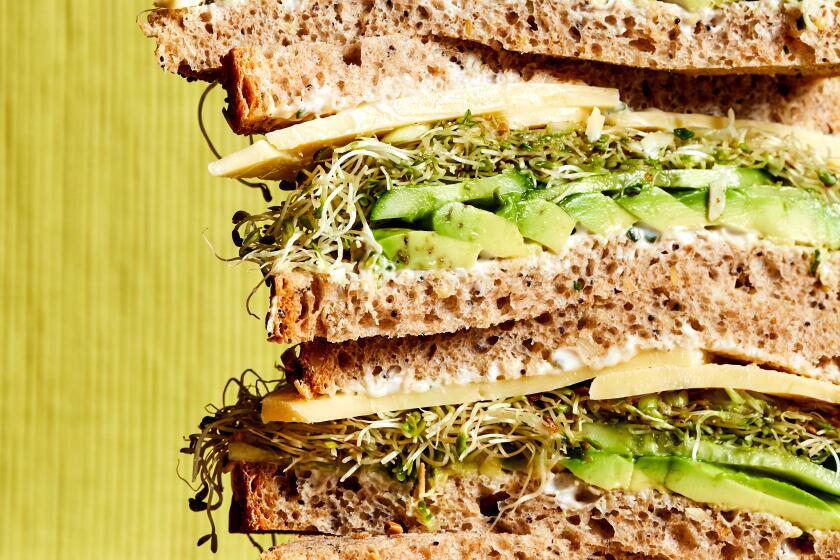Creepy-Crawlies Tickle Taste Buds : Culinary: For starters, Mexican menus may feature such delicacies as ant pupae and butterfly and moth larvae. Palm grubs are a popular food on three continents.
The Insect Club in downtown Washington, D.C., has suffered a setback. Gone from the menu are crispy cricketburgers, mealworm won tons and pizzas with cricket toppings.
The chef who created these culinary delights left, so now the nightclubâs more adventuresome customers can get in tune with the creepy decor by munching trail mix laced with baked crickets and mealworms.
âWe had to keep serving bugs in some form,â explained co-owner Rob Newkirk. âOur customers demanded it. Regulars bring their friends here to try them. Itâs sort of a rite of passage.â
Most people in the United States, Canada and Europe wonât even touch a bug, much less eat one. But in Mexico, Latin America, Africa, Asia and Australia, creative recipes for winged and crawly things abound.
âThereâs been a revival of insect-eating in Mexico,â said Darna L. Dufour, an anthropologist at the University of Colorado at Boulder. âMexicans now have quite an elaborate insect cuisine thatâs served in some fine restaurants. It may be a back-to-their-roots kind of thing.â
Mexican menus may feature such delicacies as ant pupae and butterfly and moth larvae, fried or roasted in butter, chili or garlic sauce.
In Colombia, grilled queen ants are a seasonal specialty relished by the affluent. Dufour remembers trying them during a reception at the U.S. Embassy in Bogota. âThey had a strong taste, kind of like bacon bits,â she recalls.
Weevil larvae, known as palm grubs and roughly âthe size of small mice,â are a popular food in South America, Africa and Asia, Dufour said. Amazonians sometimes cultivate them by felling palm trees, which are then invaded by weevils that produce several pounds of grubs per tree in a few months.
Some Amazonian Indians serve the white, fatty-looking creatures smoked. Dufour compares their appearance to German bratwurst. âThe grubs have a strong, cheesy taste,â she said. âYou either like them or you donât.â
The insect epicure cautioned against over-large servings of South American termites: âToo many can give you heartburn.â
In sub-Saharan Africa, most people consume at least one species of caterpillar. The mopanie worm, known as âthe snack that crawls,â is a favorite African food that is fried, dried or stewed in tomato sauce. The tasty insect has become so popular that people fear it may be eaten to extinction in some places.
âSome trendy Australian restaurants are featuring bush tucker, which includes the original foods of the Aborigines, such as witchetty grubs,â said Gene R. DeFoliart, a University of Wisconsin entomologist and editor of The Food Insects Newsletter.
In Vietnam, âGrasshoppers as big as your thumb, stuffed with minced peanuts, often make a formidable piece de resistance, â said Vietnamese-born Germaine Swanson, a Washington restaurateur. But, she made it clear, theyâre not part of the cuisine at her establishment.
Insects double as food and medicine in China. No prescriptions are needed for ant concoctions in wine, syrups, pastes and powder, which are used to treat everything from asthma to insomnia.
The outstanding performance of a womenâs track team at a September, 1993, meet in Beijing aroused suspicions of steroids or other drugs--until the coach revealed a well-guarded secret. He attributed his hard-charging teamâs success to quaffing large quantities of a potion brewed from a rare worm found on western Chinaâs high plateau.
Thereâs no question that some insects are rich in minerals and vitamins. Studies by experts in many parts of the world have concluded that the increased use of insects as food could provide more nutrition in many poor countries. Bugs could also bolster local economies.
âIf insects become more widely accepted as a respectable food item in the industrial countries,â DeFoliart said, âthe economic implications are obvious. They would form a whole new class of foods made to order for low-input business and small-farm production. International trade in edible insects would almost certainly increase.â
Dufour compares the food value of ants, palm grubs and caterpillars to that of goose liver, pork sausage and beef liver. She found that some Amazonian insects contain more protein than dried fish.
Using crickets and long-horned grasshoppers in protein feeds for animals, DeFoliart found the quality to be as high as soybean-based meals.
For human gastronomes, recipes in DeFoliartâs newsletter have included caterpillar crunch, grasshopper fritters and mealworm quiche.
The chance that creepy-crawlies will tickle American, Canadian and European palates on a large scale any time soon? Slim.
But many Americans who patronize âmore yuppified restaurantsâ--Dufourâs description--already consume them without realizing it. Nasturtium flowers, a salad ingredient, frequently conceal tiny insects beneath the petals.
More to Read
Eat your way across L.A.
Get our weekly Tasting Notes newsletter for reviews, news and more.
You may occasionally receive promotional content from the Los Angeles Times.










